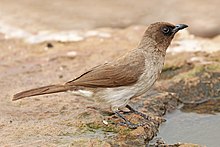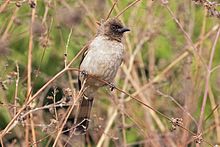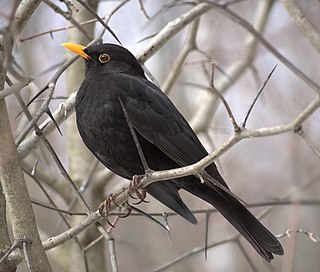
True thrushes are medium-sized mostly insectivorous or omnivorous birds in the genus Turdus of the wider thrush family, Turdidae. The genus name Turdus is Latin for "thrush". The term "thrush" is used for many other birds of the family Turdidae as well as for a number of species belonging to several other families.

The yellow-eared bulbul is a species of songbird in the bulbul family of passerine birds. It is an endemic resident breeder in the highlands of Sri Lanka. The common name is also used as an alternate name for the yellow-throated bulbul.

The white-browed bulbul is a member of the bulbul family of passerine birds. It is a resident breeder in Sri Lanka and peninsular India. Largely olive coloured above with whitish underparts, it has a pale supercilium and a yellow vent. They are found in dense scrub habitats, where they skulk within vegetation and can be difficult to see although their loud and distinct burst of calls is distinctive.

The red-vented bulbul is a member of the bulbul family of passerines. It is a resident breeder across the Indian subcontinent, including Sri Lanka extending east to Burma and parts of Bhutan and Nepal. It has been introduced in many other parts of the world and has established itself in New Zealand, Argentina, Tonga and Fiji, as well as parts of Samoa, Australia, USA and Cook Islands. It is included in the list of the world's 100 worst invasive alien species.

The black bulbul, also known as the Himalayan black bulbul or Asian black bulbul, is a member of the bulbul family of passerine birds. It is found primarily in the Himalayas, its range stretching from India eastward to Southeast Asia. It is the type species of the genus Hypsipetes, established by Nicholas Aylward Vigors in the early 1830s. There are a number of subspecies, mostly varying in the shade of the body plumage which ranges from grey to black, and some also occur in white-headed morphs, as also suggested by its specific epithet leucocephalus, literally "white head". The legs and bill are always rich orange-red.
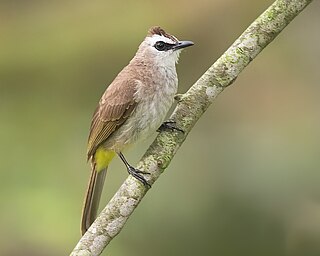
The yellow-vented bulbul, or eastern yellow-vented bulbul, is a member of the bulbul family of passerine birds. It is a resident breeder in southeastern Asia from Indochina to the Philippines. It is found in a wide variety of open habitats but not the deep forest. It is one of the most common birds in cultivated areas. They appear to be nomadic and roam from place to place regularly.
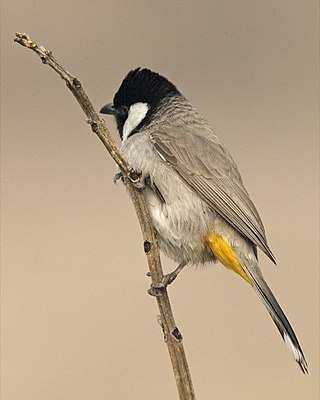
The white-eared bulbul is a member of the bulbul family. It is found in south-western Asia from India to the Arabian peninsula.
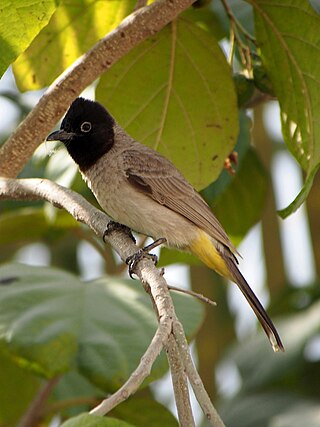
The white-spectacled bulbul is a member of the bulbul family. It is 20–25 cm (7.9–9.8 in) in length with a wingspan of 20–25 cm (7.9–9.8 in). These birds live in fruit plantations, gardens, and cities. It is the most common member of the bulbul family in Israel and Lebanon. In Turkey, it is mainly found in the coastal Mediterranean region, but its range extends from Patara/Gelemiş near Kaş in the west to Türkoğlu in the east. Breeding populations are found from Central and Southern Turkey to Western Syria, Lebanon, Israel, Western Jordan, Palestine, Sinai and western, central and southern Arabia.

The Cape bulbul is a member of the bulbul family of passerine birds. It is an endemic resident breeder in coastal bush, open forest, gardens and fynbos in western and southern South Africa. This species nests mainly in the southern spring from September to November. The nest is a thick-walled cup concealed by foliage in a small tree or shrub.
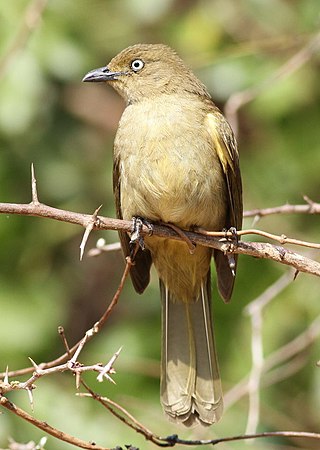
The sombre greenbul is a member of the bulbul family of passerine birds. It is a resident breeder in coastal bush, evergreen forest and dry shrub land in eastern and southern Africa. It is the only member of the genus Andropadus.
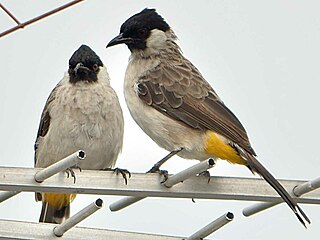
The sooty-headed bulbul is a species of songbird in the Bulbul family, Pycnonotidae. It is found in south-eastern Asia. Its natural habitat is subtropical or tropical moist lowland forests.
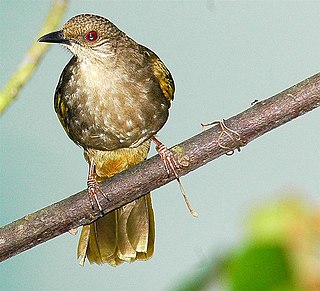
Pycnonotus is a genus of frugivorous passerine birds in the bulbul family Pycnonotidae.
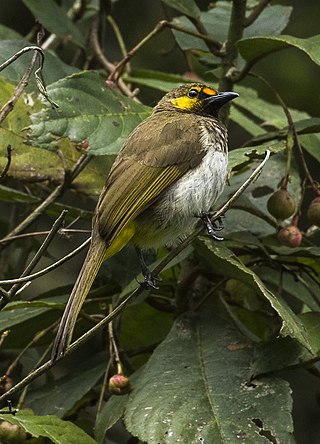
The orange-spotted bulbul is a species of songbird in the bulbul family of passerine birds. It is endemic to Java, Bali and Sumatra.

The Asian red-eyed bulbul is a member of the bulbul family of passerine birds. It is found on the Malay Peninsula, Sumatra, and Borneo. Its natural habitat is subtropical or tropical moist lowland forests.

The Himalayan bulbul, or white-cheeked bulbul, is a species of songbird in the bulbul family found in Central and South Asia.
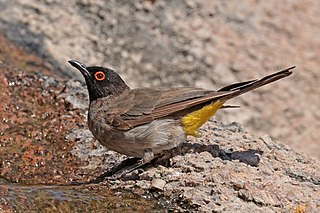
The African red-eyed bulbul or black-fronted bulbul is a species of songbird in the family Pycnonotidae. It is found in south-western Africa. Its natural habitats are dry savanna, subtropical or tropical dry shrubland, and riverine scrub. It feeds on fruit, flowers, nectar, and insects.

The dark-capped bulbul is a member of the bulbul family of passerine birds. It is found in central, eastern and south-eastern Africa.
The Somali bulbul is a member of the bulbul family of passerine birds. It is found in north-eastern Africa.
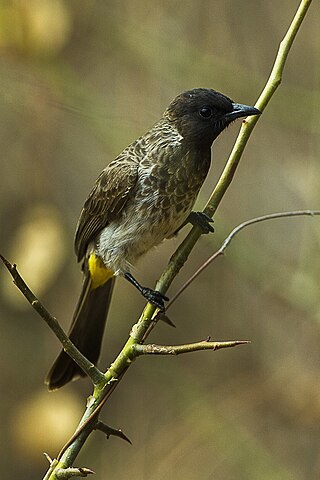
Dodson's bulbul is a member of the bulbul family of passerine birds. It is found in eastern Africa.
Brown bulbul may refer to species in the bulbul family of birds:
